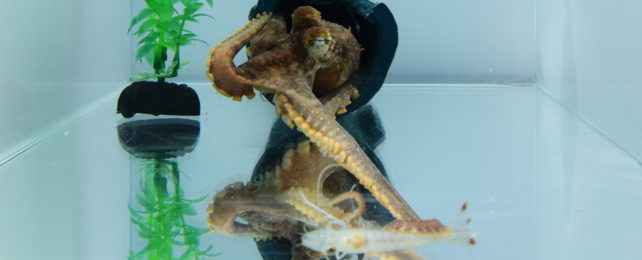Keeping two arms and two legs coordinated isn't always easy. Not only do octopuses have double the number of limbs to manage, their arms behave as if they have a mind of their own.
New research suggests the task of motor control might be simplified by sticking to a preferred arm to catch prey.
Using California two-spot octopuses (Octopus bimaculoides), researchers tested the invertebrates' response to crabs and shrimp dropped into their tanks. The octopuses were hidden inside dens, with one eye peering out. Hundreds of video clips revealed how the octopuses consistently used the second arm from the middle, on the side where their watchful eye was, to trap their prey. When necessary, the neighboring arms were also employed.
"Although the eight arms share gross anatomy and are considered equipotential, such arm use for specific actions could reflect subtle evolutionary adaptations," the researchers write in their published paper.
Crabs and shrimp move differently, and at different speeds, causing octopuses to use vary their attack methods for each. A pouncing, cat-like movement led by the second arm was used for crabs for example, which scuttle much slower than flitting shrimps.
For the quicker and more evasive shrimps, the octopuses led more slowly with the second arm, possibly incorporating subtle motions that help camouflage the arm's movements.
"The octopus is renowned for mimicry during foraging, and we speculate that it sways its arms near the shrimp to habituate the shrimp's antenna and uropod sensory hairs, thereby reducing its likelihood of a tail-flick escape," the researchers write.
Once contact was made, the neighboring arms (numbered one and three) were then used to secure the helpless prey.
The consistency of the second arm attack was somewhat surprising, given octopuses often look anything but coordinated, but the researchers say it's likely to do with their field of vision (as has been suggested by earlier studies).
"As each eye of the octopus covers about 180 degrees with virtually zero intersection and displays limited eye movement and no head movement, it is likely that octopuses prefer to place the target in the middle rather than at the border of their visual field," write the researchers.
Seconds count when it comes to catching food out in the wild of course, and it seems as though by simplifying the capture process and using multiple arms, the octopuses can maximize their chances of getting some food.
The next step for biologists would be to analyze how neuron activity is linked to such precise motor movements. The scientists don't think the octopus central nervous system is necessarily involved in recruiting additional arms to capture prey – instead it's likely to be more of a reflex action.
Having a better understanding of the mechanics behind this arm coordination could also help in the development of soft robots, the researchers say, especially those that are going to be working underwater.
"Octopuses are extremely strong," says biologist and study author Trevor Wardill, from the University of Minnesota. "For them, to grasp and open a door is trivial, given their dexterity."
"If we can learn from octopuses, then we can apply that to making an underwater vehicle or soft robot application."
The research has been published in Current Biology.
